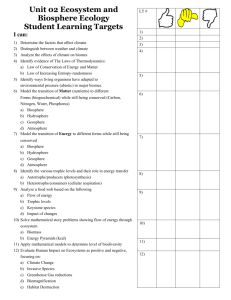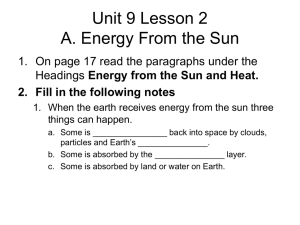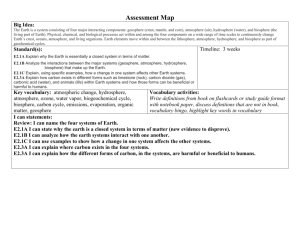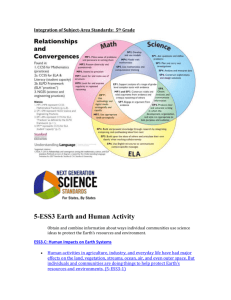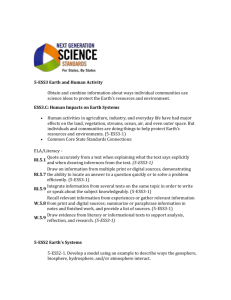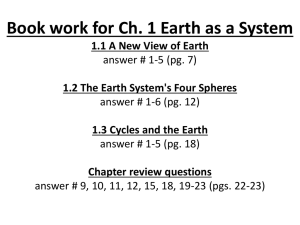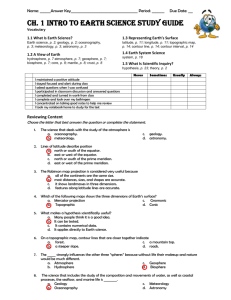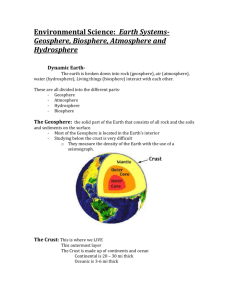Earth Science - Michigan Water Stewardship Program
advertisement
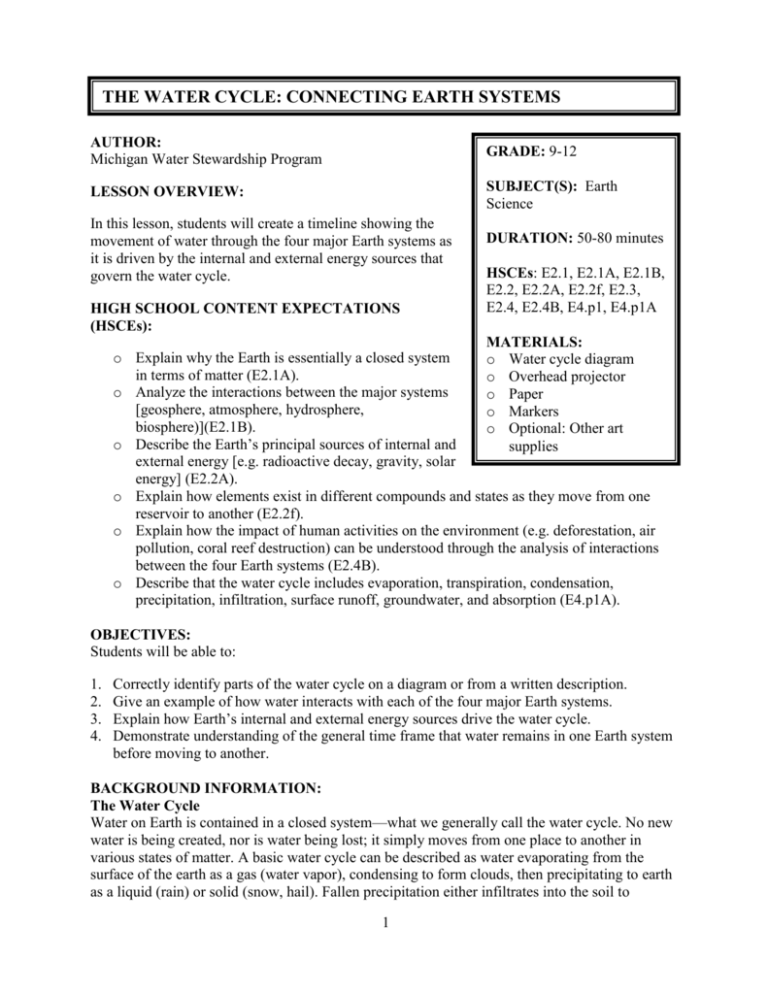
THE WATER CYCLE: CONNECTING EARTH SYSTEMS AUTHOR: Michigan Water Stewardship Program GRADE: 9-12 LESSON OVERVIEW: SUBJECT(S): Earth Science In this lesson, students will create a timeline showing the movement of water through the four major Earth systems as it is driven by the internal and external energy sources that govern the water cycle. HIGH SCHOOL CONTENT EXPECTATIONS (HSCEs): DURATION: 50-80 minutes HSCEs: E2.1, E2.1A, E2.1B, E2.2, E2.2A, E2.2f, E2.3, E2.4, E2.4B, E4.p1, E4.p1A MATERIALS: o Explain why the Earth is essentially a closed system o Water cycle diagram in terms of matter (E2.1A). o Overhead projector o Analyze the interactions between the major systems o Paper [geosphere, atmosphere, hydrosphere, o Markers biosphere)](E2.1B). o Optional: Other art o Describe the Earth’s principal sources of internal and supplies external energy [e.g. radioactive decay, gravity, solar energy] (E2.2A). o Explain how elements exist in different compounds and states as they move from one reservoir to another (E2.2f). o Explain how the impact of human activities on the environment (e.g. deforestation, air pollution, coral reef destruction) can be understood through the analysis of interactions between the four Earth systems (E2.4B). o Describe that the water cycle includes evaporation, transpiration, condensation, precipitation, infiltration, surface runoff, groundwater, and absorption (E4.p1A). OBJECTIVES: Students will be able to: 1. 2. 3. 4. Correctly identify parts of the water cycle on a diagram or from a written description. Give an example of how water interacts with each of the four major Earth systems. Explain how Earth’s internal and external energy sources drive the water cycle. Demonstrate understanding of the general time frame that water remains in one Earth system before moving to another. BACKGROUND INFORMATION: The Water Cycle Water on Earth is contained in a closed system—what we generally call the water cycle. No new water is being created, nor is water being lost; it simply moves from one place to another in various states of matter. A basic water cycle can be described as water evaporating from the surface of the earth as a gas (water vapor), condensing to form clouds, then precipitating to earth as a liquid (rain) or solid (snow, hail). Fallen precipitation either infiltrates into the soil to 1 recharge groundwater or runs off to join surface water where the cycle can begin again. This movement from place to place and from state to state incorporates all four of the major Earth Systems and is driven by Earth’s internal and external energy sources. The Water Cycle Connects the Four Earth Systems Water is present in each of the four major Earth systems (hydrosphere, atmosphere, geosphere, and biosphere) and readily moves from one to another. For example, water in the hydrosphere can evaporate to become part of the atmosphere. Through precipitation, water in the atmosphere can return to the hydrosphere or percolate into the ground to become groundwater—part of the geosphere. Water in the geosphere can be discharged into surface water, becoming part of the hydrosphere once again, or it could be drawn up into the roots of a plant and become part of the biosphere. Water in the biosphere can be released into the atmosphere through transpiration in plants, or respiration in animals. Animals may also excrete water that may enter into the hydrosphere or geosphere. These are only a few examples—water can move from one system to any of the others in a variety of ways. Energy Sources that Drive the Water Cycle The movement of water among the four Earth systems is driven by Earth’s internal and external sources of energy. One of Earth’s internal sources of energy—gravity—provides the energy for precipitation to occur. Gravity also enables fallen precipitation to either infiltrate the geosphere to become groundwater or run off over the surface of the ground to join the surface water of the hydrosphere. Earth’s primary source of external energy—the sun—provides the solar energy that warms the surface of the earth and enables evaporation to occur. These two energy sources acting simultaneously on the Earth’s water cause the water’s movement among the Earth’s systems to be cyclical. Time Scales All water on Earth is not constantly moving between systems and transforming to different states of matter. A drop of water frozen in a glacier, for instance, may remain there for thousands of years before melting and infiltrating into the geosphere or evaporating into the atmosphere. Likewise, a drop of water in a deep groundwater aquifer may remain there unchanged for millennia. However, a rain drop soaking into parched soil may quickly be absorbed by a thirsty plant and transpired, thus moving from atmosphere to geosphere to biosphere and back to the atmosphere in rapid succession. VOCABULARY: Aquifers, atmosphere, biosphere, clouds, condensation, evaporation, external energy sources, geosphere, glaciers, gravity, groundwater, hail, hydrosphere, interactions of earth systems, internal sources of energy, precipitation, recharge, rivers, solar energy, streams, surface water lakes, transforming mater and/or energy, water vapor . PROCEDURE: Warm-Up (Anticipatory Set): Review basic information about the water cycle, earth systems, and internal/external energy sources with the class. 2 Project the water cycle diagram and have students help you label the Earth systems that are depicted. Draw in a sun and a downward facing arrow for students to label the energy sources that affect the water cycle. Ask students to think about how long a single drop of water may remain in one of the Earth systems before moving to another. Discuss several scenarios. Transition from the warm-up review to the activity by explaining that although the movement and transformation of water is cyclical (it happens over and over again), it is not a circle (it does not follow a fixed order or pattern). Point out that the water cycle diagram you are using shows a simplified lake-to-clouds-to-rain-to-lake circle, but the reality is much more complex. Activity: Students may work individually or in small groups for this activity. 1. Ask students to think of a specific example of how they have used water or have seen water being used today. Good examples for this activity would be something like steam rising from a cup of coffee or a sprinkler watering a lawn. 2. Have students imagine that they are following a single drop of that water on its journey through the water cycle. They will create a hypothetical timeline that documents the journey through 8 to 12 scenarios. This is the outline or “map” that will help them create their project in Step 3. For each scenario the student must include the following information: Location and Description of Movement (e.g. “soaking into my neighbor’s lawn” or “rising into the sky over Lake Michigan”) State of Matter (solid, liquid, or gas) Earth system (hydrosphere, geosphere, biosphere, or atmosphere) Energy Source (which source of energy caused the movement or change?) Time (how long will it remain there?) – this is largely up to the student’s imagination, but they should try to represent the general time scale; i.e. if their water droplet ends up in the ocean it will usually remain there much longer than if it ends up in a mud puddle. 3. Once the student has completed the information for their timeline, they will choose one of the following projects: Write a journal from the water drop’s perspective, including all the information from the timeline in a story format. Create a poster to graphically represent the water drop’s journey (like the water cycle diagram used in the warm-up review), with the required information written out beside each step of the journey. Wrap-Up (Closure): Have students present their projects to the rest of the class. Afterward, ask the students to answer these questions: Whose water droplet moved the most? The least? Why? Would these projects be different if you had created your timeline with a water droplet from 200 years ago? From 2 million years ago? From 1,000 years in the future? 3 What effect would it have if your water droplet had gotten polluted at one step in its journey? Which Earth systems would be affected? How would this affect humans? ASSESSMENT OPTION: Ask the students the following questions: Under what circumstances might the effects of gravity and/or the sun cause water to be tied up in a certain part of the water cycle, thus affecting our ability to access clean, drinkable water? Describe human activities on the environment (e.g. deforestation or shoreline or stream bank erosion) have on the way water moves through the water cycle. What can be done to minimize these effects? Describe an example in which water takes a very long time for water to travel through each Earth system. What would happen if all water moved at this slow pace? Would all of our water needs be met? Why or why not? EXTENSIONS: Have students rewrite their timelines as if their water droplet was polluted. Have them add a line to record what negative effects the polluted water droplet might have on the various Earth systems it passes through and how this may ultimately affect humans. Have students research an actual pollution event involving water and have them trace the effect on various Earth systems. 4 5

